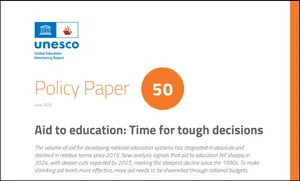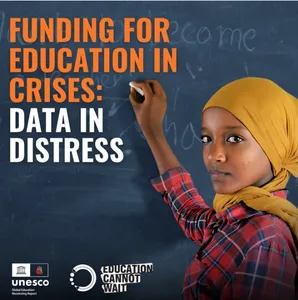Reports Highlight Value of IATI in Tracking Education Aid

Two recent policy papers from the Global Education Monitoring (GEM) Report team highlight the vital role of the International Aid Transparency Initiative (IATI) in tracking education aid across the world.
Aid to Education: Time for Tough Decisions and Funding for Education in Crises: Data in Distress (co-authored with Education Cannot Wait) use IATI’s real-time data to uncover the latest trends in education financing.
By combining IATI with other major sources—including the OECD’s Creditor Reporting System (CRS) and OCHA’s Financial Tracking Service (FTS)—the reports present a more complete picture of development and humanitarian financing of education.

Aid to Education: Time for Tough Decisions
Released in June 2025, this policy paper reviews the current state of aid for developing national education systems. While total aid volumes appeared to rise between 2016 and 2023 (largely due to budget support to Ukraine and a significant increase in scholarships), IATI data indicates a reversal of this trend in 2024.
Aid to Education: Time for Tough Decisions states (page 1):
“Aid to education is projected to fall by a quarter between 2023 and 2027. Analysis of IATI data set suggests that aid may already have fallen by 12% in 2024. Announcements made by major donors in early 2025 suggest there will be at least a further 14% fall by 2027”.
“the added value of IATI lies in its timeliness” —Aid to Education: Time for Tough Decisions
The paper highlights that “the added value of IATI lies in its timeliness”, which enabled analysis of education aid beyond 2023 (which is the most recent data available from the OECD CRS). IATI data can be updated by organisations (including donors) daily, allowing policymakers and analysts to monitor shifts in aid flows in near real time.
The report also highlights other qualities of IATI data that are valuable in tracking development and humanitarian funding:
- Project-level granularity that enables detailed tracking;
- Disaggregation by donor, recipient, subsector, modality, and implementing agency;
- Flexibility to capture multiple transaction types—including incoming funds and expenditure;
- Faster detection of changes in donor behaviour and funding priorities.

Funding for Education in Crises: Data in Distress
Funding for Education in Crises: Data in Distress written with Education Cannot Wait (ECW), focuses specifically on education in emergencies and protracted crises (EiEPC). It draws on data from IATI, CRS, and FTS to explore trends and challenges in crisis financing, and calls for greater harmonisation between the three systems.
Since 2024, the IATI Secretariat has supported Education Cannot Wait with its country-level work in six pilot countries, advising on methodology, and connecting ECW with other thematic communities to strengthen peer learning. While many of the global findings in the report were led by the GEM Report team, the paper also draws on ECW’s experience in applying IATI data at country level to improve coordination and planning.
“One of the advantages of analysing the IATI database is the flexibility in disaggregation by subsector” —Funding for Education in Crises: Data in Distress
IATI data enabled a range of insights shared in the paper:
- Timely insights into funding flows: IATI data accessed in May 2025 revealed a rebound in funding for crisis-affected settings in 2024, rising from USD 952 million to USD 1.3 billion. This goes beyond tracking the trend across all data sources, which reported a 20% fall in EiEPC funding in 2023.
- Expanded visibility of key financing flows: IATI enabled analysis of data published by a wider range of education actors, including pooled funds like ECW and the Global Partnership for Education.
- Improved recipient-level detail: While donors publish 80% of ECW disbursements under the category “Developing countries, unspecified” in the CRS, IATI data contained more information about recipient countries. Using IATI data directly published by ECW, the paper was able to show that nearly half of their 2024 funding went to six countries: Bangladesh, Chad, Ethiopia, the State of Palestine, South Sudan, and Ukraine.
- Detailed disaggregation by subsector: This paper says “One of the advantages of analysing the IATI database is the flexibility in disaggregation by subsector”. From 2019 to 2024, IATI showed that 40% of crisis education aid supported basic education, 30% went to sector-wide policy and management, and support to upper secondary education nearly tripled—insights not available from the other data sources.
Challenges and Opportunities
While both policy papers highlight the added value of IATI data, they also identify several persistent challenges in tracking education financing.
- Aid to Education: Time for Tough Decisions offers detailed observations and recommendations to strengthen the data available through IATI. The paper calls for more bilateral and multilateral donors to publish their data, greater harmonisation of reporting practices—including alignment with CRS methodology—and clearer classification of aid flows and organisation roles across diverse publishers.
- Funding for Education in Crises: Data in Distress highlights a key challenge: no single dataset fully captures the complexity of education financing in crisis contexts. The paper points to fragmented donor reporting across platforms, noting that among the 20 largest donors in ECW’s six pilot countries, three reported only to FTS and four solely through IATI. It also underscores how inconsistent use of the “humanitarian” tag in IATI data limits compatibility with other systems, and reflects broader differences in classification—such as FTS’s ability to categorise all education funding under a single EiE label (not included in the IATI Standard).
A shared push for harmonisation
IATI fully supports the call for greater alignment between development and humanitarian reporting standards to improve coherence and usability of data.
IATI fully supports the call for greater alignment between development and humanitarian reporting standards to improve coherence and usability of data. Although the GEM–ECW report shows that overall trends across the three sources are broadly consistent, there needs to be increased coordination to align the main reporting systems and improve the reporting standards.
IATI has recently been working to improve interoperability between IATI and FTS, where, since 2024, IATI has been supporting Denmark’s Ministry of Foreign Affairs (Danida) to pilot the use of IATI data in a format compatible with FTS. IATI is also co-leading the Bridging Data Systems for Financing for Development initiative, launched at the Fourth International Conference on Financing for Development (FfD4) with the International Forum on TOSSD, OECD, and UN CEB Secretariat.
Looking ahead
IATI welcomes the findings from both reports and is committed to working with ECW, the GEM Report team, FTS, the OECD, and other partners to improve the tracking of education financing. As outlined in the IATI Workplan 2025, the Secretariat will continue to proactively support data use by thematic communities—helping to ensure that IATI data is not only transparent, but also accessible and actionable for those making decisions that shape education outcomes.